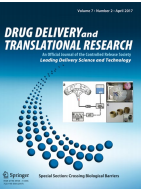Drug Delivery and Translational Research Update
2016 DDTR Outstanding Research Paper Award Winner 
The Selection Committee and CRS are pleased to announce the following paper published in DDTR during 2016 for the award. Criteria such as translation nature of research, overall impact, innovation, and significance of the study were considered in the selection process. The award is jointly sponsored by Springer-Nature and CRS. The corresponding authors will be recognized at the 44th CRS Annual Meeting & Exposition hosted in Boston, Massachusetts, U.S.A., July 16–19, 2017. Please join us in congratulating authors of the paper for their outstanding achievement.
Riboflavin-induced photo-crosslinking of collagen hydrogel and its application in meniscus tissue engineering
Jiseung Heo, Rachel H. Koh, Whuisu Shim, Hwan D. Kim, Hyun-Gu Yim, and Nathaniel S. Hwang Drug Deliv. Transl. Res. 6(2): 148-158, 2016
In this paper, the authors have tissue engineeried a scaffold that can potentially be used as a meniscus tissue. Meniscus significantly contributes to knee health by playing a critical role in shock absorption, load distribution, and joint stabilization. Meniscus tears are known to occur readily with aging or extreme exercising. However, when it happens the inner region of the meniscus has limited regeneration capacity due to the lack of blood vessels. Numerous studies have been conducted to develop an optimal treatment strategy for meniscus tears, which include allograft transplantation, menisectomy, and meniscus substitution. In this paper, the authors have investigated riboflavin as a photo-sensitizer for photo-crosslinking of collagen hydrogel scaffolds for meniscus tissue engineering. The chemical crosslinking results from the covalent bond formation between amino acids of collagen fibril induced by singlet oxygen generated from light-excited riboflavin. This riboflavin-induced collagen crosslinking mechanism has been approved for clinical application in cornea tissues. As collagen fibers account for 90% w/v of meniscus tissue, their study utilized the riboflavin-induced crosslinking system to enhance the mechanical property and overall stability of collagen-based scaffolds as a clinically safe method. In addition, the group also demonstrated that hyaluronic acid, which has been shown to promote meniscus regeneration, can be incorporated into the collage scaffolds. Furthermore, the results of gene expression analysis and histology suggest that fibrochondrocytes encapsulated in crosslinked collagen hydrogel with hyaluronic acid showed enhanced expression of meniscus tissue related genes and extracellular matrix production. These results indicate that the physically improved collagen hydrogel can be potentially applied.
About the Corresponding Author
 Nathaniel S. Hwang (nshwang@snu.ac.kr) is currently an associate professor in the School of Chemical and Biological Engineering at Seoul National University, Republic of Korea. Since March 2017, he has been the director of the Interdisciplinary Graduate Program in Bioengineering, and he is also a member of the Institute for Chemical Processes at Seoul National University and the Stem Cell Graduate Program at the Seoul National University, Republic of Korea. Dr. Hwang received a bachelor’s degree in biomedical engineering from Johns Hopkins University Whiting School of Engineering in 2002. He obtained his Ph.D. in biomedical engineering from the Johns Hopkins School of Medicine in 2007 under the guidance of Prof. Jennifer Elisseeff. After doctoral studies, he was a visiting scholar at the University of California, San Diego, Department of Bioengineering, and worked with Prof. Shyni Varghese. From 2008 through 2011, he worked as a postdoctoral associate in Prof. Robert Langer’s laboratory at Massachusetts Institute of Technology. In 2011, Dr. Hwang joined the School of Chemical and Biological Engineering at Seoul National University.
Nathaniel S. Hwang (nshwang@snu.ac.kr) is currently an associate professor in the School of Chemical and Biological Engineering at Seoul National University, Republic of Korea. Since March 2017, he has been the director of the Interdisciplinary Graduate Program in Bioengineering, and he is also a member of the Institute for Chemical Processes at Seoul National University and the Stem Cell Graduate Program at the Seoul National University, Republic of Korea. Dr. Hwang received a bachelor’s degree in biomedical engineering from Johns Hopkins University Whiting School of Engineering in 2002. He obtained his Ph.D. in biomedical engineering from the Johns Hopkins School of Medicine in 2007 under the guidance of Prof. Jennifer Elisseeff. After doctoral studies, he was a visiting scholar at the University of California, San Diego, Department of Bioengineering, and worked with Prof. Shyni Varghese. From 2008 through 2011, he worked as a postdoctoral associate in Prof. Robert Langer’s laboratory at Massachusetts Institute of Technology. In 2011, Dr. Hwang joined the School of Chemical and Biological Engineering at Seoul National University.
Dr. Hwang is currently leading a group of students that work together to develop new biomaterials, study stem cells, and design new technologies for regenerative medicine. In particular, Dr. Hwang’s laboratory is working toward the fabrication of bio-synthetic microenvironments conducive to stem cell differentiation by manipulating scaffold properties and incorporating the desired biological signals. In addition, Dr. Hwang’s laboratory is developing non-viral strategies for a direct conversion stem cell technology. He has published over 66 research articles and book chapters covering biomaterials and stem cells for musculoskeletal tissue regeneration.
Join the leading scientists who are publishing their work in DDTR and also compete for the 2017 DDTR outstanding research/clinical paper award. The paper will be selected from the research articles/clinical research/clinical trials published in DDTR during 2017. The award will be presented in 2018 during the 45th CRS Annual Meeting. Visit the CRS website for the award criteria (www.controlledreleasesociety.org/about/Awards/Pages/DDTROustandingPaper.aspx).

